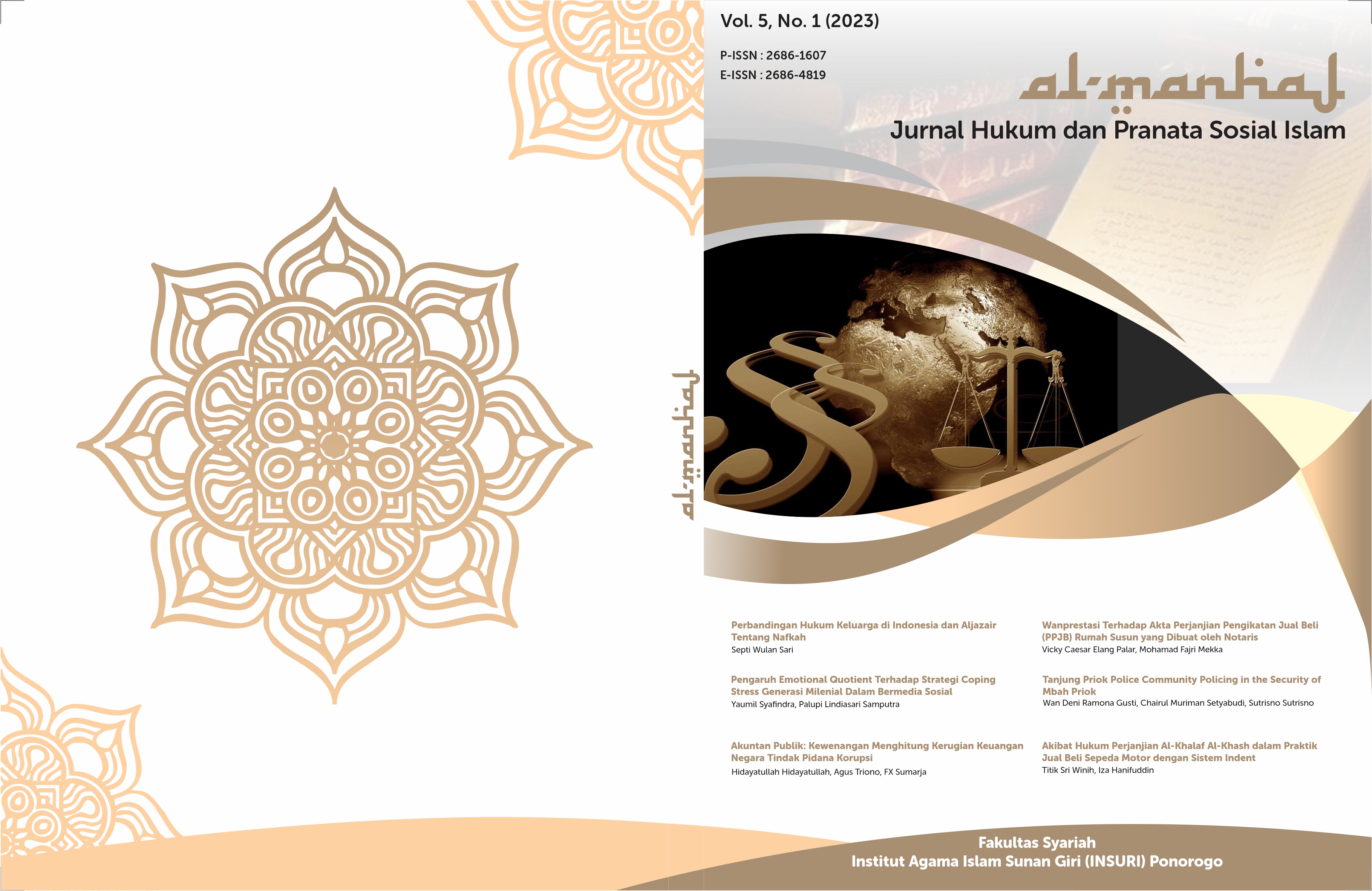Tinjauan Yuridis Tanggung Jawab Hukum dalam Perjanjian Kredit Perbankan Apabila Debitur Wanprestasi
DOI:
https://doi.org/10.37680/almanhaj.v5i1.2364Keywords:
Credit; Banking; Legal ResponsibilityAbstract
Humans are social beings who need each other to achieve what will be achieved. The goal is to communicate thoughts and feelings that arise from his common sense. With the relationship between humans with one another, this can also happen between humans and banks. Which human or someone will lend funds or credit to banks. But in reality, someone who has done credit financing does not follow the agreement and causes default. Thus, the occurrence of this default resulted in a person having to take legal responsibility to resolve the problem. Therefore, This research focuses on the legal principles in default regulations in banking and legal responsibility in resolving default debtor problems. This paper aims to explain the juridical review and legal responsibility in bank credit agreements if the debtor defaults. The research method uses a normative juridical approach that has descriptive characteristics. The result of this study is a juridical review based on the Banking Law and legal responsibility is carried out by mediation first so that the debtor and creditor can choose a middle way. If the debtor cannot resolve the case, then the final solution is to file a lawsuit with the court based on an agreement between the two parties.
Downloads
References
Ahmad Muhammad Al-Assal. (1980). An Nizamul Iqtisadi fil Islam mabadi’uhu wahdafuhu, Alih bahasa Abu Ahmadi. Bina Ilmu.
Amiruddin, & Asikin, Z. (2008). Pengantar Metode Penelitian. Raja Grafindo Persada.
Anshori, A. G. (2008). Tanya Jawab Perbankan Syariah. UII Press.
Anshori, A. G. (2010). Hukum Perjanjian Islam Di Indonesia. Mada Universitas Press.
Badrulzaman, M. D. (1983). Perjanjian Kredit Bank . Alumni.
Budiono, H. (2011). Ajaran Umum Hukum Perjanjian Dan Penerapan Di Bidang Kenotariatan. Citra Aditya Bakti.
Departemen Agama. (2014). Al-Qur’an Al-Karim Dan Terjemahnya. PT. Diponegoro.
Departemen Pendidikan dan Kebudayaan. (1989). Kamus Besar Bahasa Indonesia. Balai Pustaka.
Hamzah, A. (2005). Kamus Hukum, , 2005. Ghalia Indonesia.
Hermansyah. (2005). Hukum Perbankan Nasional Indonesia. Prenada Media.
Ishaq. (2017). Metode Penelitian Hukum dan Penulisan Skripsi, Tesis, serta Disertasi (p. 115). Alfabeta.
Kelsen, H. (2006). Teori Umum Tentang Hukum Dan Negara . PT. Raja Grafindo.
Mamudji, S., & Soekanto, S. (2001). Penelitian Hukum Normatif (Suatu Tinjauan Singkat). Rajawali Press.
Mariam Darus Badrulzaman. (2001). Kompilasi Hukum Perikatan (p. 28). PT.Citra Aditya.
Marzuki, P. M. (2009). Pengantar Ilmu Hukum. Kencana Prenada Media Group.
Moleong, L. J. (2007). Metodologi Penelitian Kualitatif. PT Rosdakarya.
Muhammad, A. (2010). Hukum Perdata Indonesia. Citra Aditya Bakti.
Muljadi, K., & Widjaja, G. (2003). Perikatan Yang Lahir Dari Perjanjian. Raja Grafindo Persada.
Mustaqien, R. (2006). Teori Hukum Murni Nuansa & Nusa Media. Rajawali Pres.
Putra, R. K. (2016). Gugatan Wanprestasi Atas Putusan Akta Perdamaian Di Pengadilan Negeri Semarang Putusan Nomor 436/Pdt.G/2014/PN Smg. Diponegoro Law Journal, Volume 5 Nomer 3.
Rahadrjo, S. (2000). Ilmu Hukum (p. 55). PT. Citra Aditya Bakti.
Ridwan HR. (2016). Hukum Administrasi Negara. Rajawali Pers.
Soemardi. (2007). General Theory Of law and State, Teori Umum Hukum dan Negara, Dasar-Dasar Ilmu Hukum Normatif Sebagai Ilmu Hukum Deskriptif Empirik. BEE Media Indonesia.
Usman, R. (2001). Aspek-aspek hukum perbankan di indonesia. gramedia.
Utami, A. L. (2011). Kesepakatan Perdamaian Sebagai Alternatif Penyelesaian Sengketa Antarpersero PT. MMC. Fakultas Hukum Universitas Indonesia
Downloads
Published
How to Cite
Issue
Section
License
Copyright:
- Author retains the copyright and grants the journal the right of first publication of the work simultaneously licensed under a Creative Commons Attribution 4.0 International License that allows others to share the work with an acknowledgment of the work's authorship and initial publication in this journal.
- Author is able to enter into separate, additional contractual arrangements for the non-exclusive distribution of the journal's published version of the work (e.g., post it to an institutional repository or publish it in a book) with the acknowledgment of its initial publication in this journal.
- Author is permitted and encouraged to post his/her work online (e.g., in institutional repositories or on their website) prior to and during the submission process, as it can lead to productive exchanges, as well as earlier and greater citation of the published work (See The Effect of Open Access).
License:
-
Attribution — You must give appropriate credit, provide a link to the license, and indicate if changes were made. You may do so in any reasonable manner, but not in any way that suggests the licensor endorses you or your use.
-
No additional restrictions — You may not apply legal terms or technological measures that legally restrict others from doing anything the license permits.
You are free to:
- Share — copy and redistribute the material in any medium or format
- Adapt — remix, transform, and build upon the material for any purpose, even commercially.

This work is licensed under a Creative Commons Attribution 4.0 International License.














